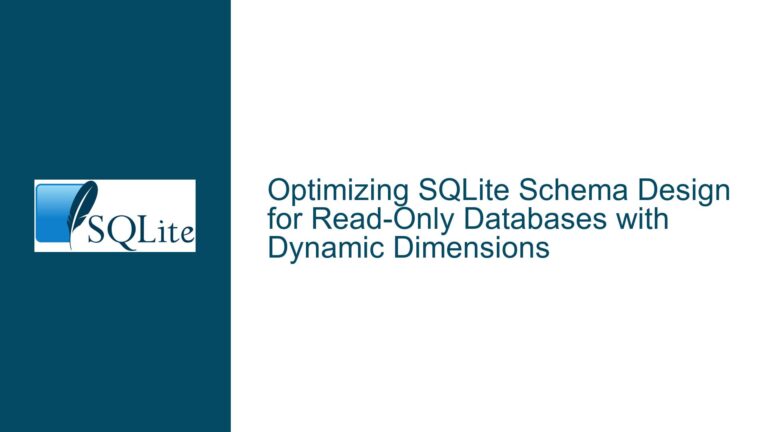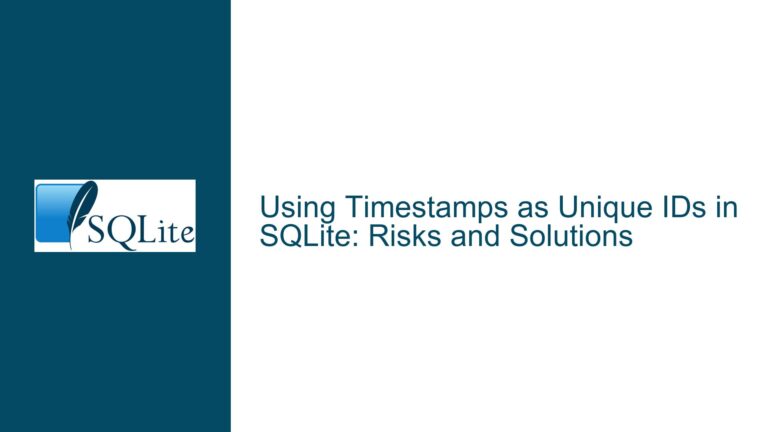Handling Decimal Data in SQLite: Affinity Conflicts and Storage Solutions
Understanding Decimal Data Storage and Affinity Conflicts in SQLite
The core challenge revolves around storing decimal values in SQLite while avoiding unintended type conversions and data loss. SQLite’s type affinity system, combined with the behavior of the decimal extension, creates a conflict when columns are declared as DECIMAL. This conflict arises because SQLite assigns a NUMERIC affinity to columns declared with type names like DECIMAL, NUMERIC, or FLOAT. Columns with NUMERIC affinity will automatically convert input values to integers or floating-point numbers when possible. This conversion occurs even if the input is explicitly bound as text (e.g., via sqlite3_bind_text), leading to silent data loss when decimal precision exceeds what IEEE 754 doubles can represent.
The decimal extension, designed to handle arbitrary-precision arithmetic, expects its input as TEXT or BLOB values. However, due to NUMERIC affinity, text values bound to DECIMAL columns are first converted to integers or floats. For example, inserting the string '123.456' into a DECIMAL column will result in a double-precision float if the value cannot be represented as an integer. This defeats the purpose of using the decimal extension, which relies on textual or binary representations of exact decimal values.
A historical workaround involved binding values as BLOBs to bypass affinity-driven conversions. Before the checkin 8baf8c10aecb10a7, the decimal extension treated BLOBs as valid input for decimal arithmetic. However, post-checkin, the decimal function now interprets 8-byte BLOBs as IEEE 754 doubles, limiting their utility for arbitrary-precision storage. This change forces developers to choose between explicit type handling and compatibility with SQLite’s affinity rules.
Root Causes of Data Loss and Compatibility Issues with the Decimal Extension
1. NUMERIC Affinity and Implicit Type Conversions
SQLite’s type affinity system prioritizes flexibility over strict typing. When a column is declared as DECIMAL, it does not enforce a decimal type but instead applies NUMERIC affinity. This means:
- Text values are converted to integers if they match an integer format (e.g.,
'123'→123). - Remaining text values are converted to floats (e.g.,
'123.456'→123.456as a double). - BLOB values are stored verbatim, but their interpretation depends on extension functions.
The decimal extension, however, requires textual representations (e.g., '123.456') or specialized BLOB formats to preserve precision. When text is bound to a NUMERIC affinity column, SQLite’s automatic conversion destroys the original textual representation, making it unusable for exact decimal arithmetic.
2. Evolution of the Decimal Extension’s BLOB Handling
Prior to the checkin mentioned in the discussion, the decimal extension accepted BLOBs as arbitrary-precision values. Developers could bind BLOBs containing decimal strings (e.g., UTF-8 bytes of '123.456') to bypass affinity conversions. Post-checkin, the extension’s decimal() function was modified to interpret 8-byte BLOBs as IEEE 754 doubles, aligning it with the ieee754 extension. This change introduced two issues:
- BLOBs not exactly 8 bytes long are rejected by the
decimal()function. - Storing decimals as IEEE 754 BLOBs reintroduces precision limitations (e.g.,
0.1cannot be represented exactly).
3. Misalignment Between Column Semantics and Storage Requirements
Users often declare columns as DECIMAL expecting SQLite to enforce decimal-specific storage or validation. However, SQLite treats DECIMAL as a hint for NUMERIC affinity, not as a true decimal type. This mismatch leads to:
- Data Loss: Text-bound decimals are converted to floats, truncating precision.
- Fragile Workarounds: Relying on BLOBs requires careful handling and is now incompatible with the
decimal()function. - Confusion with Strict Tables: While SQLite’s STRICT tables enforce type checks, they do not support a native
DECIMALtype, forcing developers to useTEXTorBLOBmanually.
Resolving Decimal Storage Conflicts: Best Practices and Alternative Approaches
1. Use TEXT Affinity for Decimal Columns
Declare columns as TEXT to avoid NUMERIC affinity conversions:
CREATE TABLE financial_data (
amount TEXT -- TEXT affinity preserves exact string representation
);
When inserting data, bind values as text using sqlite3_bind_text or equivalent methods in your programming language. The decimal extension will correctly parse these text values.
Example Workflow:
- Insert
'123.45678901234567890123456789'as text. - Use
decimal_add(amount, '0.0')in queries to ensure amount is treated as a decimal.
2. Avoid DECIMAL Column Declarations
SQLite does not natively support decimal types, so declaring DECIMAL columns is counterproductive. Instead, document that decimal values are stored as text and enforce this convention in application code.
3. Migrate Existing DECIMAL Columns to TEXT
For legacy tables, recreate columns with TEXT affinity:
ALTER TABLE financial_data RENAME COLUMN amount TO amount_old;
ALTER TABLE financial_data ADD COLUMN amount TEXT;
UPDATE financial_data SET amount = CAST(amount_old AS TEXT);
ALTER TABLE financial_data DROP COLUMN amount_old;
4. Leverage the IEEE754 Extension for Compact Storage
If storage efficiency is critical and limited precision is acceptable, use the ieee754 extension to store doubles as 8-byte BLOBs:
INSERT INTO data VALUES (ieee754(123.456));
Retrieve values using ieee754_to_blob() and ieee754_from_blob().
5. Use STRICT Tables for Type Enforcement
Enable STRICT mode to prevent implicit type conversions:
CREATE TABLE financial_data (
amount TEXT
) STRICT;
This ensures that only text values can be inserted into amount, avoiding accidental integer/float conversions.
6. Custom Type Handling in Application Code
Implement a middleware layer to serialize/deserialize decimals:
- Serialization: Convert decimals to strings or structured BLOBs before insertion.
- Deserialization: Parse strings/BLOBs back into decimal types after retrieval.
Example (Python):
import decimal
import sqlite3
conn = sqlite3.connect(':memory:')
conn.execute('CREATE TABLE data (value TEXT)')
d = decimal.Decimal('123.45678901234567890123456789')
conn.execute('INSERT INTO data VALUES (?)', (str(d),))
result = conn.execute('SELECT value FROM data').fetchone()
restored_d = decimal.Decimal(result[0])
7. Advocate for Future UDT Support
While SQLite lacks user-defined types (UDTs), its record format allows for experimental approaches. For example, prefix BLOBs with a header indicating a custom decimal type:
# Pseudocode for custom BLOB format
blob = b'DECIMAL:' + str(decimal_value).encode('utf-8')
UDT-aware functions could then parse these BLOBs while ignoring other applications.
8. Framework and ORM Considerations
If using an ORM like SQLAlchemy or Django, override column types to enforce text storage:
# SQLAlchemy example
from sqlalchemy import Column, Text
class FinancialData(Base):
__tablename__ = 'financial_data'
amount = Column(Text)
9. Educational and Documentation Strategies
Educate stakeholders on SQLite’s type system quirks:
- Emphasize that
DECIMALis a type hint, not a strict type. - Provide code samples showing correct/incorrect storage methods.
- Highlight the risks of silent data loss with NUMERIC affinity.
10. Evaluate Alternative Databases for Decimal-Centric Workloads
For applications requiring native decimal support, consider databases like PostgreSQL (with NUMERIC type) or DuckDB (SQLite-like syntax with decimal support). Reserve SQLite for scenarios where its lightweight nature outweighs the need for strict typing.
By adhering to these practices, developers can mitigate affinity-related data loss and ensure reliable decimal arithmetic in SQLite. The key takeaway is to treat SQLite as a typeless storage engine with affinity hints, requiring explicit handling of decimal values at the application layer.






